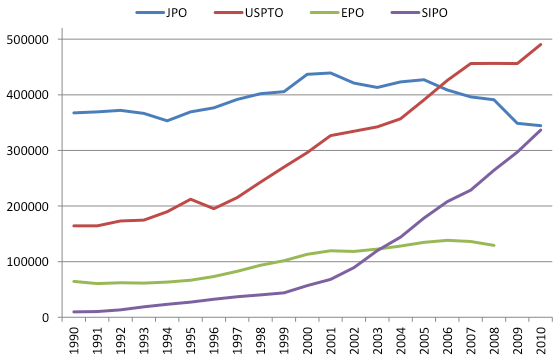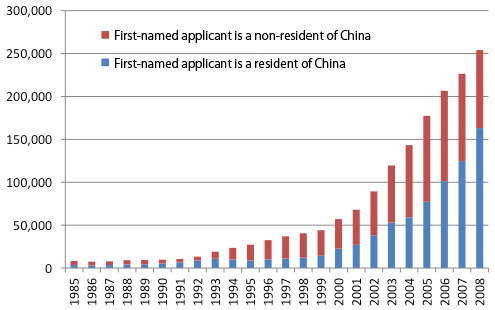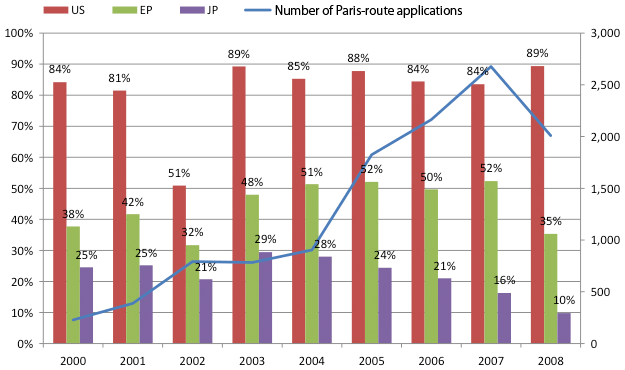Introduction
In recent years, the number of patent applications filed in China has been rising rapidly, as seen in statistics released by the World Intellectual Property Organization (WIPO) and the patent authorities of China and other countries. The number of patents filed with the State Intellectual Property Office (SIPO) of China has increased significantly over the years and reached a level comparable to those of the United States and Japan (WIPO, 2010) (see Figure 1).
In what follows, I would like to discuss the trend and characteristics of patent applications in China with reference to findings from recent research studies in and outside the country. The data used include those from the China Intellectual Property Right Net (CNIPR) database operated by the Intellectual Property Publishing House (IPPH) and those from the Worldwide Patent Statistical Database (PATSTAT) of the European Patent Office (EPO). It should be noted, however, that the database of patent information in China has yet to be established sufficiently and data are fraught with missing values (JIPA 2012).

Growing number of patent applications filed by Chinese enterprises
Foreign companies?such as those from Japan, the United States, and Europe?used to account for a large majority (approximately 70% in the latter half of the 1990s) of patent applications filed with the Chinese patent authorities. However, the number of applications filed by Chinese enterprises has been growing significantly in recent years. According to SIPO statistics, patent applications filed by residents of China exceeded those filed by nonresidents in 2003 and accounted for about 75% in 2010.
Since the datasets used in this article provide information on the country of residence only of the first-named applicant in each application, a degree of reservation is needed. However, based on the information available thus far, the number of applications filed by residents of China has increased markedly since 2000, as shown in Figure 2.

Applications filed from outside China are mostly done by multinational companies, typically for the purpose of securing production and market access in the country. Lerner (2002) showed that strengthening patent protection has led to an increase in the number of patent applications filed by multinational companies. China amended the Patent Law in 2001 and joined the World Trade Organization (WTO) in the same year. This suggests that the establishment and implementation of the patent system in accordance with the WTO Agreement on Trade-Related Aspects of Intellectual Property Rights (TRIPS) has contributed to the increase in the number of patent applications filed from overseas. Meanwhile, Hu (2010) analyzed data for years through 2004 aggregated by industry and found that the number of patent applications filed from outside China is particularly large in sectors where foreign countries have strength in exports to China. It is thus fair to say that a greater opening of the Chinese market is leading to an increase in the number of patent applications from outside the country.
Apart from analyzing the factors behind the increasing number of applications from abroad, research focusing on the factors boosting the number of domestically-filed patent applications has been and is being undertaken. Hu and Jefferson (2009) showed that increasing research and development investment and foreign direct investment by Chinese enterprises, coupled with the establishment of the current enhanced patent system, has led to an increase in patent applications filed by Chinese enterprises. Meanwhile, Choi, Lee and Williams (2011) focused on the relationship between the ownership structure of Chinese enterprises (based on data from 548 firms) and the number of patents registered in the period from 2001 through 2004, concluding that those with foreign ownership or affiliated with foreign business groups tend to file a larger number of patents registered than those without any foreign affiliation. Furthermore, as Li (2012) points out, it is inferred that subsidies offered by provincial governments have been a significant contributing factor.
Quality of patents held by Chinese enterprises
Given the rapid increase in patent filings by Chinese enterprises, the next question of interest is the quality of their patents or patented technologies. It is difficult to measure the value of patents directly. We take a look at applications filed by residents of China with overseas patent authorities as an indicator. When companies apply for patents overseas, they typically file applications with the patent authorities within their respective countries first and then either claim priority under the Paris Convention (Paris-route applications) or file international applications under the Patent Cooperation Treaty (PCT).
It is presumed that the higher the quality of patents, the greater is the likelihood that patent holders will file patent applications overseas. Hereinafter, I would like to examine the extent to which Chinese enterprises seek to secure patents outside China via the Paris route, using data extracted from the CNIPR and PATSTAT.
In doing so, I focus on applications filed solely by residents of China as I believe that overseas filing behavior would be quite different in the case of joint inventions with foreign firms from that in the case of inventions made by Chinese enterprises alone.
Based on this definition, only about 13,000 Paris-route applications have been filed by Chinese enterprises to date. As such, the number remains very small. However, when we look at the trend over the years, the number of applications increased more than tenfold from 228 in 2000 to 2,676 in 2007 (see Figure 3).
The United States is the top destination of overseas patent application filings. Those filed with the United States Patent and Trademark Office (USPTO) accounted for approximately 80% of the overseas patent applications filed by Chinese enterprises during the period covered in Figure 3, with the cumulative number standing at about 10,000, followed by about 6,000 with the EPO and about 3,000 with the Japan Patent Office (JPO).

According to patent practitioners, some of the patented or potentially patentable technologies of Chinese enterprises are believed to have extremely high value. Although I limited my discussion here to patents, it has been pointed out that in China, the strategy for utility models is just as important as that for patents. Meanwhile, the number of patent litigations is so large that the situation is beyond comparison with that of Japan.
As such, for Japanese companies, patent strategy in the Chinese market will likely become all the more important going forward.


